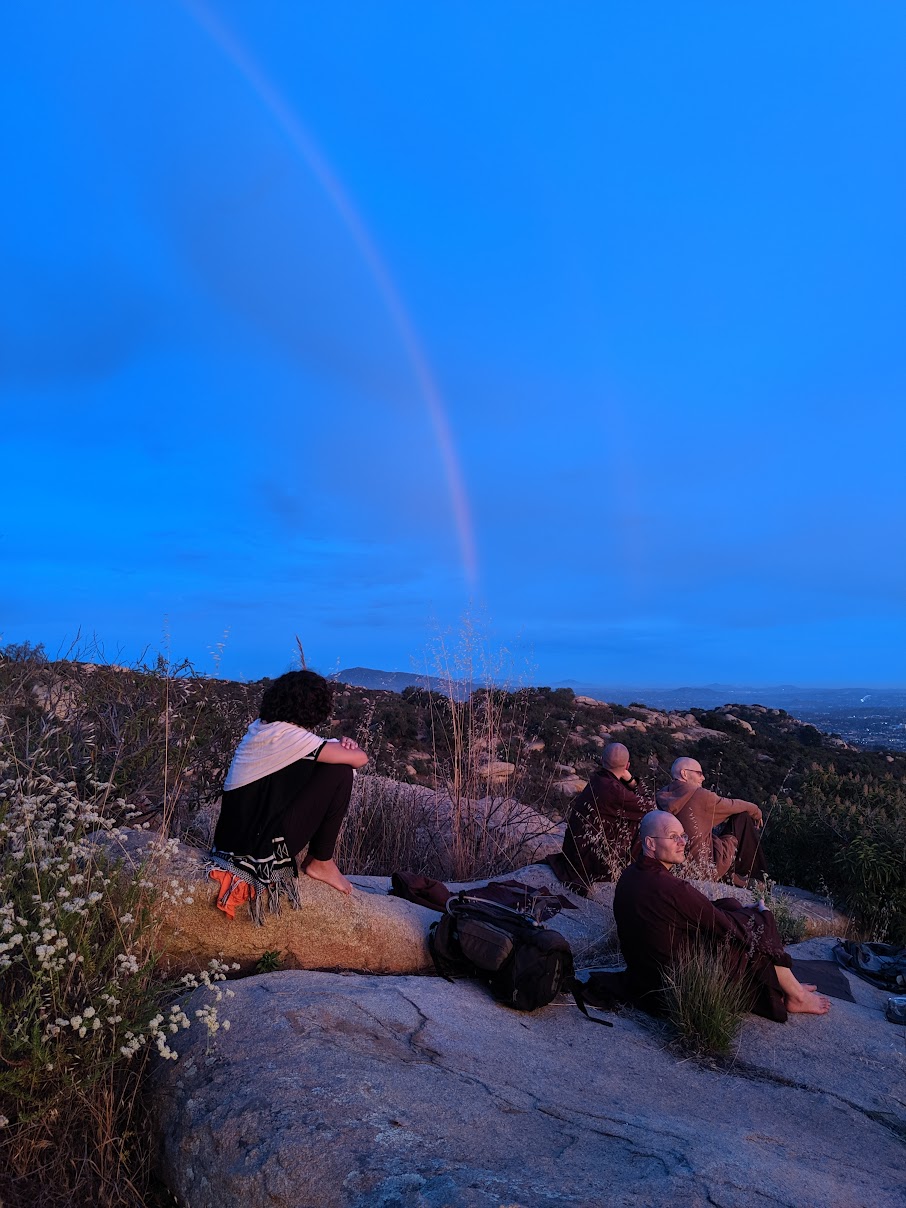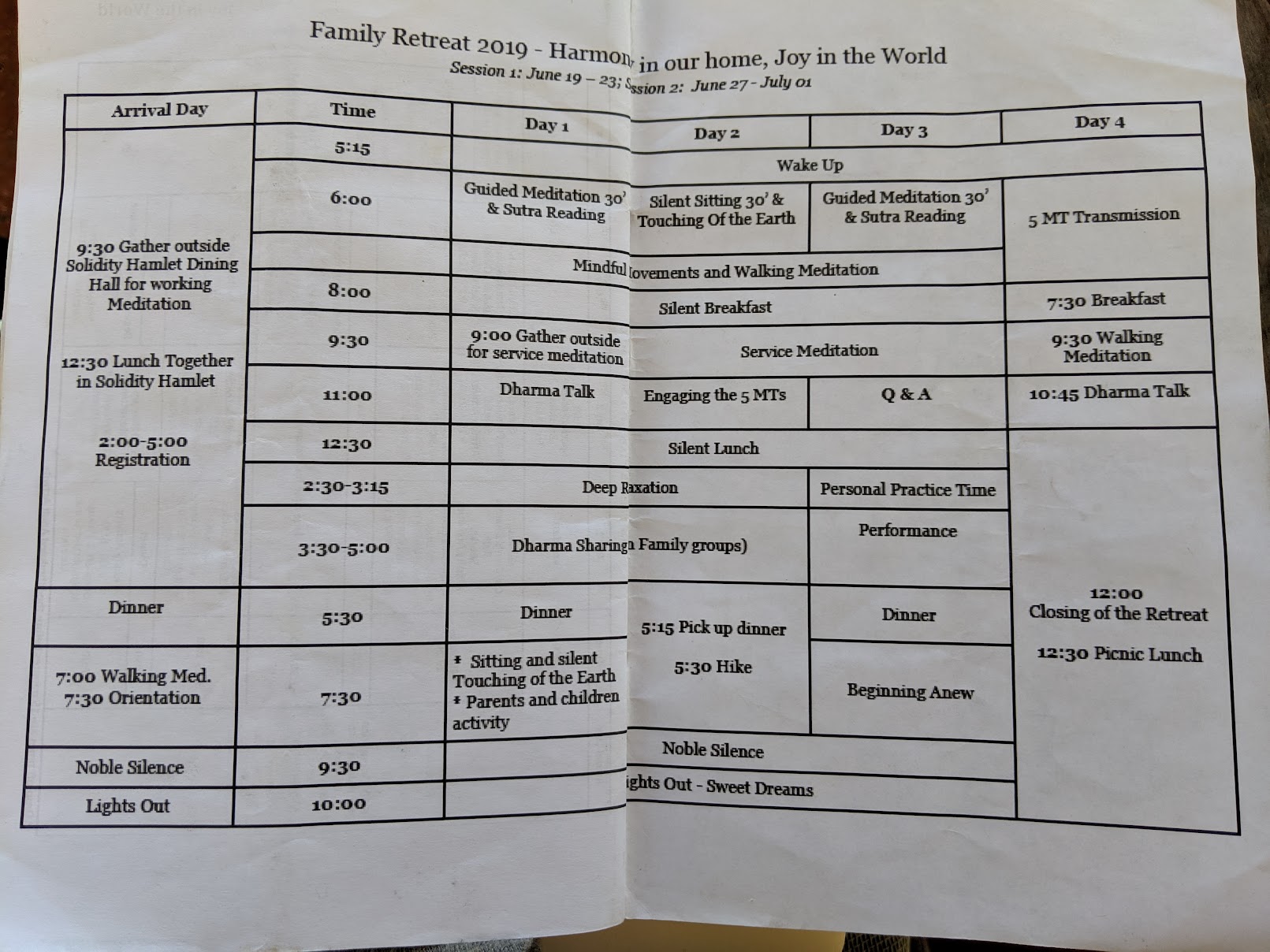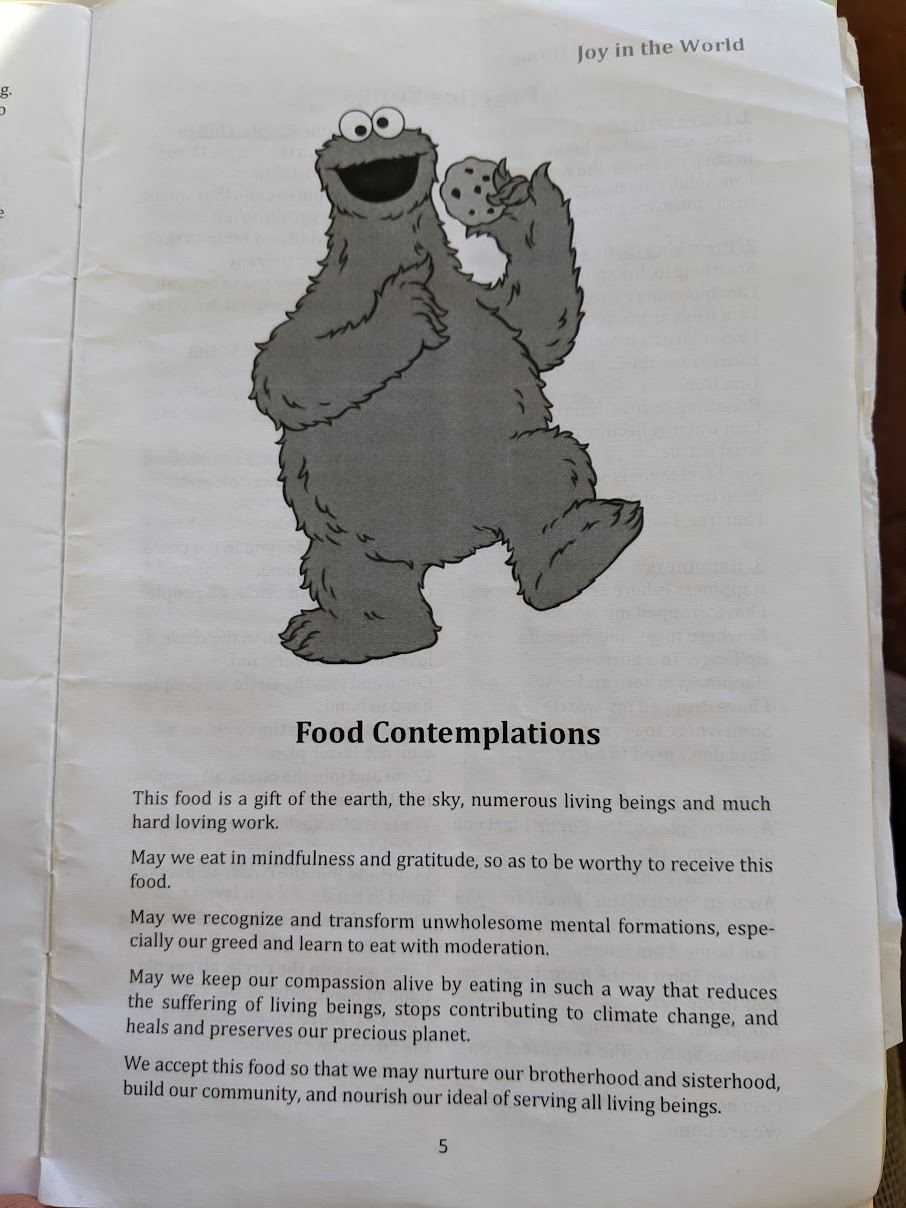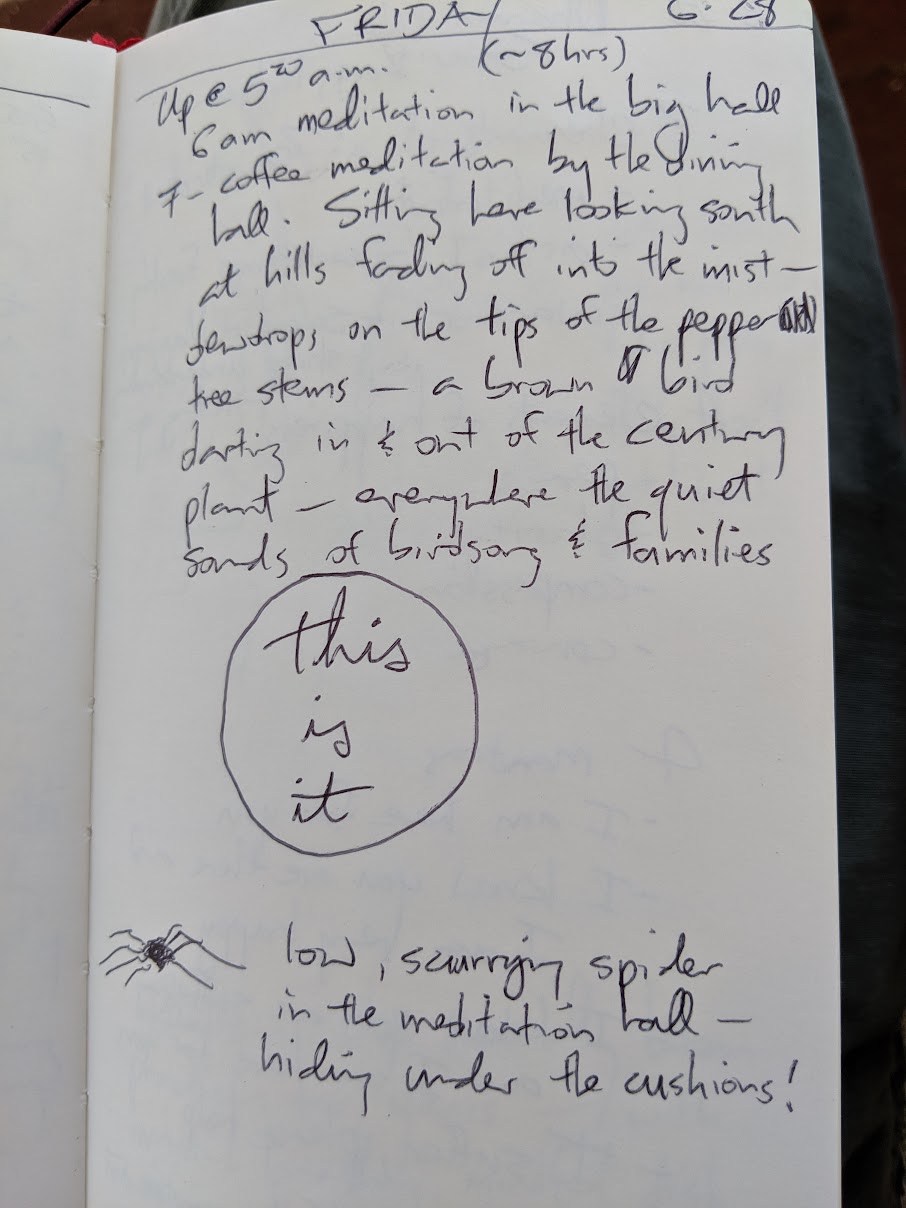
A Zen monastery isn’t the kind of destination you’d typically think of taking the family on vacation, but that’s what we did this summer. I got up very early one morning in late June, shoveled the 18 year old and the 12 year old into the car, along with some basic camping gear, and drove south for approximately 8 hours, until we arrived at the gates of Deer Park, a Zen monastery in the Plum Village tradition, founded by Thich Nhat Hanh. (My wife didn’t come with us for the retreat, but she joined us later that week in Los Angeles.)
Deer Park is in Escondido, in the San Diego area, up in the hills. The family retreat takes place over a long weekend: You arrive on Thursday afternoon and leave Monday morning, giving you four nights and three full days, plus two half days, at the monastery. Is that a five-day retreat, a four-day retreat, or a three-day retreat? I don’t know. I do know that it was enough time for a little transformation to happen.
I was a little nervous going in, because I’d never been to a Plum Village retreat before and had no idea what the weekend would hold. But over the course of the retreat, we all relaxed and became a bit more mindful. I started to touch a deep feeling of peace and had a few insights that extended my meditation practice. And the kids had an awesome time and were begging to come back even before we had left.
The monks and nuns who run the monastery wear brown robes and shaved heads, and they’re supported by a team of lay volunteers who seemed to be everywhere, doing everything. There’s just enough formality to the schedule to make you realize you’re on retreat, but on the whole it doesn’t feel strict or repressive or excessively “religious.” The monastics are cool, and approachable, and amazing with the children. All the kids were divided up by age groups — the 12-year-old went with the tween group and the 18-year-old with a teen group — and each age group had its own, age-appropriate program. Songs, mindfulness, activities, hiking, talking … I don’t know exactly, as the kids didn’t tell me much about what they were doing. Within the first hour or two of arriving, it was clear that both of my children were going to be very happy staying with their groups and that they needed no help or support from me, except for waking them up in the morning.
We stayed in a tent, although dorm or small room accommodations are also available. The camping area was a large sheltered area under some trees, with many other tents — nothing special, but convenient to the bathrooms and reasonably flat.

A few notable aspects of life on this retreat:
- Bells. Whenever a bell rings you are supposed to stop whatever you’re doing, hear the sound, and let it bring you back to the present moment. No matter what you’re doing, you just stop for a few moments and just stay with your breath. Then you resume whatever you were doing or saying. And there are a lot of bells! I realized after a day of this just why this organization’s magazine is called The Mindfulness Bell.
- Silent meals. When you line up for food and when you’re eating, you’re supposed to remain silent for most of the time. Kids and families are not too good at maintaining perfect silence, but for the most part we ate without talking (or with minimal, occasional whispering), at least until a bell sounded that signaled it was okay to speak. I thought that was awkward at first but it actually worked, and I wound up making friends with some table mates anyway.
- The food. Almost totally vegan. It was filling and delicious. For my daughter, a revelation: She didn’t even realize she had been eating vegan (as opposed to vegetarian) all weekend until I told her. Ice cream is also available for purchase at the bookstore during limited afternoon hours, though they are vegan, coconut “ice cream” bars, which my kids complained lightly about — but not enough to say no to them. Pro tip: Buy some wooden ice cream tokens at the bookstore and keep them in your pocket — that way your kids will be forced to return to you if they want these treats!
- Walking meditation. If you’re not used to this style of meditation, it might feel like nothing more than painfully slow walking. The idea is to walk slowly enough that you can be fully aware of each step. When you’re doing this at home, on a city street, or in a park, Thich Nhat Hanh advises walking at a normal speed, so you don’t stand out too much and make other people uncomfortable. But at a monastery, if you do walking meditation in a group led by a monk or a nun, you’re going to be walking much slower than you’re used to. Feel free to enjoy it — while you’re supposed to pay attention to your steps and your breath, you’re not actually supposed to stare at the ground ignoring everything around you. Quite the opposite: Once you get into it, this is a good way to become open to all the wonderful sights, sounds, and smells around you, and even the feel of the air and the sun on your skin. The landscape of Deer Park opened up for me on one of these walks and I was stunned by the variety and beauty of flowers, trees, birds, and other things all around.
- Deep relaxation. You don’t spend a ton of time in meditation at a family retreat — there’s a morning meditation session and an opportunity to meditate at the end of the day — but several afternoons there was a chance to participate in “deep relaxation,” which is a guided meditation you experience while lying down on flat cushions in the meditation hall, sometimes with gentle music playing. This is extremely relaxing and just the kind of thing most parents need.
- Service meditation. Every day we had to do an hour or two of working meditation. The group I was in got assigned to cleaning up the bathrooms, which was not hard. I heard that sometimes you might get assigned a job, like scrubbing pots after meals, that is harder. I didn’t have that experience — the work our group did was pretty light. At any rate, I found it was quite possible to do the work in a mindful, meditative way, much like walking meditation.
- Dharma sharing. Every day the small group I’d been assigned to for working meditation spent an hour or so in a circle, talking about our meditation practice or our experiences at the retreat. I valued this aspect of the retreat but I can see how, for someone not familiar with the Plum Village tradition, this might be uncomfortable.
- Dharma talks. These lectures, by senior monastics, gave me lots of food for thought and for meditation practice. My kids didn’t attend most of these, and I wish they had — especially one on the last day of the retreat that was actually aimed at tweens and teens, which the 12 y.o. showed up for but the 18 y.o. skipped. But they were busy doing their own things, and were free to choose what they wanted to do — which was something else.
- Practice songs. There’s a whole repertoire of Buddhist songs that people in this tradition like to sing. At the retreat these songs came alive. They’re essentially camp songs, and they’re a little goofy, but they’re fun, and they embody important ideas about the tradition and the practice and make them easier to remember. I came away having learned quite a few of them and their tunes even got stuck in my head a bit. It was a nice feeling.
- Noble silence. After the last dharma talk of the evening, or after 9pm at any rate, you’re supposed to keep silent — until after breakfast the next morning. In reality nobody’s too strict about this but it does keep things pretty quiet during sleeping hours. In a camping area filled with children all in tents in close quarters, that’s something to be grateful for.
I had a few experiences during the retreat that were especially intense. There was an evening hike up to the top of a hill, where we ate our dinners and then watched the most amazing sunset — with a simultaneous double rainbow in the opposite direction — that was an almost mystical, nearly transcendent experience of too-much-beauty for me. I wrote about this elsewhere.

There was a moment while I was eating lunch where I had a strong vision of how the food was being consumed and would soon be transformed into my body, but also how the food had started out as something else (dirt, rain, air) before being transformed into that food, and that after it had become me (and poop) it would eventually become something else again. It was a powerful sense of existing as a temporary “node,” or a process, among a bunch of interwoven streams of things-transforming-into-other-things.

I missed my kids. While I was happy they were so involved in their groups I also wished I could have connected with them a little more often. But they didn’t much want to eat meals with me, let alone go to a dharma talk or hike. I saw them at night, when we were going to sleep in the tent, and it was clear they were happy, so that was enough. And later I learned that the retreat had a powerful effect on both of them, teaching them ways of relaxing and giving them a strong sense of peace and belonging.
On the last day of the retreat there was a ceremony for a transmission of the Five Mindfulness Trainings, which is this tradition’s version of the Buddhist five precepts for lay people. Anyone who wants to receive this transmission is welcome to sign up for it, and there were 12 or 15 people who did so that morning. This ceremony doesn’t require you to become a Buddhist but it does involve monks and nuns lined up in rows in their formal yellow robes, and there’s a lot of bell ringing and bowing, which gives it some gravity. I found it beautiful and moving. It was a nice way to end the retreat.
After that we packed up our camping gear and reluctantly drove away from the gates of the monastery. Almost instantly the kids, who were terribly sugar-deprived after a few days of such healthy eating, were clamoring for Jamba Juice, so we stopped there before heading on to pick up KJ at the airport and spend a few more days of vacation in and around Santa Monica. But that’s a completely different story!

